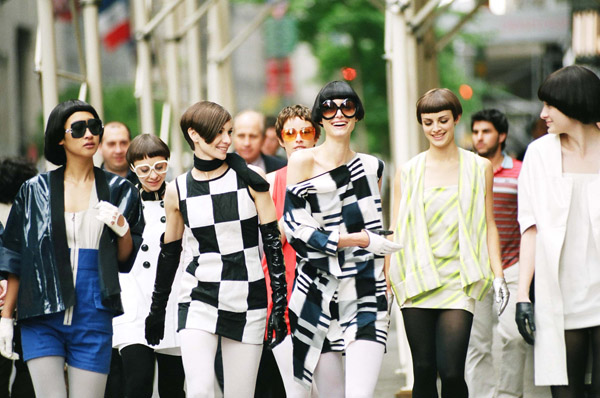|
Reviews of Recent Independent, Foreign, & Documentary Films in Theaters and DVD/Home Video

VIDAL SASSOON: THE MOVIE Vidal Sassoon: The Movie combines the first history of the evanescent art of hairstyling (as both fashion and a business) with the biography of the 20th century’s leading practitioner. There’s a lot of flattering evidence to support the promotional tag line: “How a man changed the world with a pair of scissors.” Director Craig Teper celebrated Sassoon’s 80th birthday while evocatively touring his life and its impact. Visiting places from his past, Sassoon and his memories interlace with a wonderful array of family photos, archival documentation, and clips. From the Jewish orphanage in London, where his destitute mother left him during the Depression, he recalls the peacefulness of singing in the synagogue choir. (He later adopted a child in tribute to those years). When his mother had a dream that he would be a hairstylist, she got him an apprenticeship at 14 as a shampoo boy for the white-caped Adolph Cohen in the hub of the Jewish East End. During the day, Cohen taught him manners, discipline, and crisp presentation. His nights were spent in bomb shelters during the Blitz. Sassoon chortles that he was a street tough after the war. As newsreel footage illustrates the persistence of anti-Semitic fascists in England through the 1940’s, Sassoon recalls their chants of “Let’s get rid of the yids!” He joined a gang to beat them up and then volunteered with the Palmach in Palestine, the nascent army for Israel as independence loomed. In the desert, he found spirituality and the determination to change his life. Returning to London, he worked hard to eliminate his cockney accent through elocution lessons, facilitating jobs at ever fancier beauty salons, and moved up to the salon of “the outrageous” Raymond, renowned as Teasy Weasy. Some of the best clips feature Raymond demonstrating his rigid styling techniques. Interviews describe the equally rigid atmosphere he controlled. The 1950’s context of high society hairstyling sets the stage for Sassoon’s rebellion as he began to focus on the geometry of bone structure and shaping hair the way it grows. Movie stars were his ticket to fame, with his well-publicized shearing of Nancy Kwan’s long locks and the stars of Roman Polanski films, beginning with Catherine Deneuve for Repulsion (1965). He reached Middle America via Mia Farrow’s boyish bob in Rosemary’s Baby (1968). (In subsequent interviews, Sassoon has dismissed the to-do over Emma Watson’s post-Harry Potter clipped hairdo as been there, done that.) Oddly, there’s nary a mention of anyone from his salons serving as the model for the bed-hopping stylist in Hal Ashby’s Shampoo (1975) even as former employees gossip about the rule Sassoon had to lay down: “Stop sleeping with the clients! Be professional!” (A reminder that there was a time when hairdressers weren’t stereotyped as homosexual, let alone that none were female.) How he helped define the look of the swinging sixties comes through in a mutual admiration reunion with fashion designer Mary Quant. The two warmly recall their unusual creative partnership that landed him in the pages of Vogue and into his own Madison Avenue salon in Manhattan. (In a particularly acute clip from his heyday, a TV reporter valiantly tries to question how individualized his cutting choices really are while he wields his scissors on her hair.) The workaholic Sassoon expanded his business into an international stylists’ school, best-selling book, TV show, and a huge hair-product line ripe for a multi-million dollar takeover. From his luxurious California villa, he only regrets neglecting his wives and children. The film is
a bit too artily organized around chapters in the companion book by
producer Michael Gordon, founder of the hair care company Bumble and
bumble, who admires Sassoon as a role model. More annoying is the
artifice of interviews and reconstructions in black and white that
confusingly blend into the marvelous period photos and clips. However,
unlike the narrow fashion focus of Matt Tyrnauer’s
Valentino: The Last Emperor (2008), this entertaining and
informative documentary’s in-depth biography reveals a new angle on
history that should have broader appeal.
Nora Lee Mandel
|

